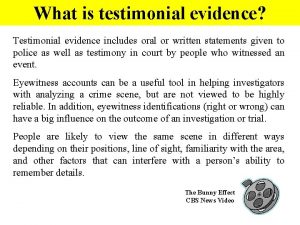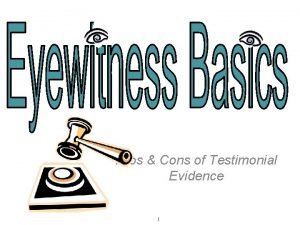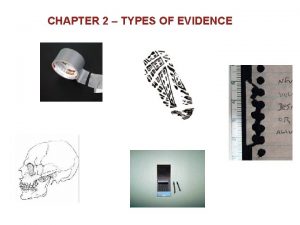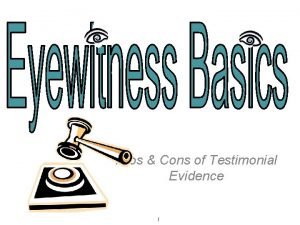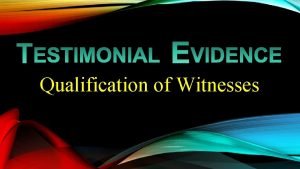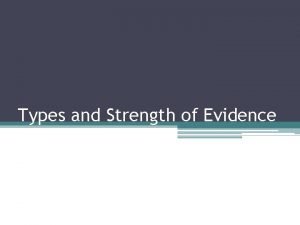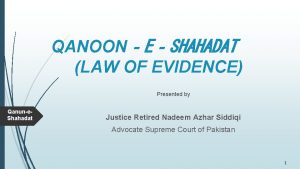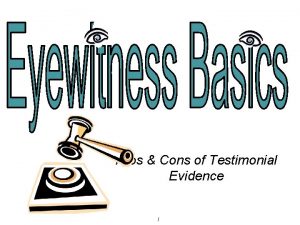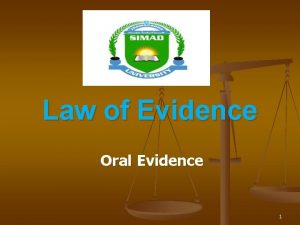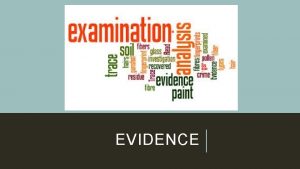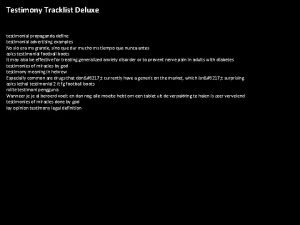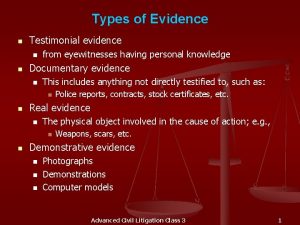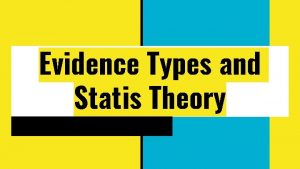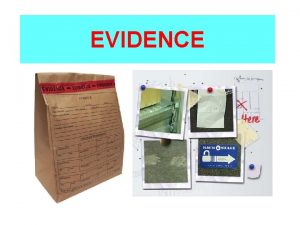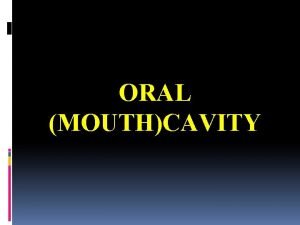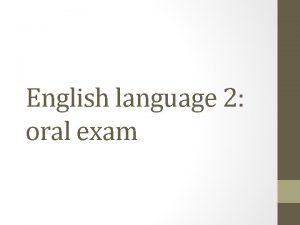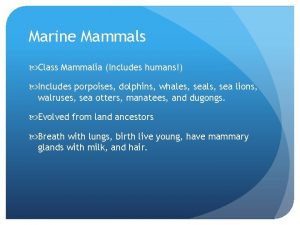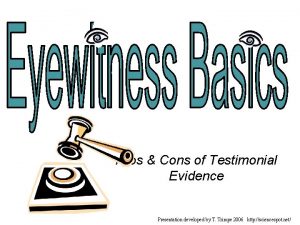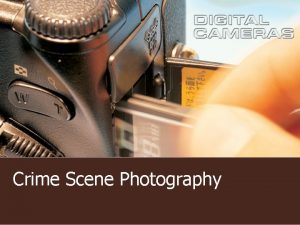What is testimonial evidence Testimonial evidence includes oral


















- Slides: 18

What is testimonial evidence? Testimonial evidence includes oral or written statements given to police as well as testimony in court by people who witnessed an event. Eyewitness accounts can be a useful tool in helping investigators with analyzing a crime scene, but are not viewed to be highly reliable. In addition, eyewitness identifications (right or wrong) can have a big influence on the outcome of an investigation or trial. People are likely to view the same scene in different ways depending on their positions, line of sight, familiarity with the area, and other factors that can interfere with a person’s ability to remember details. The Bunny Effect CBS News Video

Persuasiveness of Eyewitnesses • Most persuasive form of evidence – Eyewitnesses believed 80% of the time • Juries cannot tell the difference between an accurate and an inaccurate witness – Accurate witness believed 68% of time – Inaccurate witness believed 70% of time

Eyewitnesses are Most Persuasive When • They provide detail (trivial persuasion) • They are confident • They are adults – Children can be persuasive under certain circumstances – Elderly are perceived similar to children

Memory Challenge Directions: You will have 30 seconds to view the next screen. Try to memorize all 20 items you see! You are NOT allowed to write anything down You CANNOT talk to anyone else.

Items to remember. . . Neuroscience for Kids - http: //faculty. washington. edu/chudler/puzmatch 1. html

What do you remember? You have 2 minutes to list as many of the items as you can! How did you do?

According to The Innocence Project (2008) "Eyewitness misidentification is the single greatest cause of wrongful convictions nationwide, playing a role in more than 75% of convictions overturned through DNA testing. " Still, the criminal justice system profoundly relies on eyewitness identification and testimony for investigating and prosecuting crimes (Wells & Olson, 2003).

Witness Factors • Age may play a role in the accuracy of an eyewitness’ statement or identification of a suspect. Studies have shown that when a lineup contains the actual culprit, both young children and elderly perform well, but when the lineup does not contain the culprit there is a higher rate of mistaken identifications. • The race of the witness may also play a role. The Cross Race Effect (CRE) is a phenomenon in which people are better at recognizing faces of their own race rather than those of other races. • The use of drugs can alter a person’s ability to recall the events of a crime even after they are no longer under the influence. • A person’s memory of an event can be influenced by other witnesses, investigators, and/or the media. Investigators use open-ended questioning and follow procedures for conducting line-ups to limit their influence on a witness’ memory of an event or identification of a suspect.

Common Errors • Overestimate the height of criminals • Overestimate the duration of a brief event • Notice more about the action than the person • Pay more attention to the weapon

Crime Scene & Suspect Factors • A crime that is extremely traumatic for an eyewitness may affect his/her recall of the event. For example, a witness confronted with a weapon tends to focus on the weapon rather than the perpetrator’s face. • Someone who is able to focus on a perpetrator's face for a minute or longer will tend to have a more accurate memory than someone who saw the person for only a few seconds. • Studies have shown that faces that are either highly attractive, highly unattractive, or distinctive are more likely to be accurately recognized. Simple disguises, such as hats or sunglasses, can interfere with accurate eyewitness identification. However, body piercings and tattoos increases the likelihood of an accurate identification. • The time of day in which the crime occurred as well as a person’s view of the scene may affect what a he/she is able to see. In addition, a person who is familiar with the area in which the crime took place, may have a better recall of the positions of the victims or suspects.

Foils/Fillers/Distractors • Should look like the description rather than the actual suspect • Put most similar foils next to suspect • Use non witnesses to determine fairness of lineup • Pictures of foils and suspect must be similar (e. g. , color, background, quality)

Good Identification Practices • Include “blank” lineups • Instruct witness that suspect might not be there • Use sequential viewing • Person conducting lineup does not know who suspect is • Ask eyewitness how confident they are prior to feedback • Be careful about providing feedback about correctness of choice

Good Interview Practices • Get statement as close to the event as possible • Place the witness in the event environment • Before asking questions, ask the witness to recreate the incident in his/her mind • Start with unprompted recollection – use open-ended questions • Tell the witness – that they should do most of the talking – not to edit their thoughts; they should say whatever comes to mind

Good Interview Practices • Record both the questions asked as well as the answers • Have the witness tell the story from beginning to end; from the end to the beginning; • Have the witness tell the story from different perspectives (victim, other witnesses, perp) • Follow-up with specific questions • Elicit partial information

Avoid • Leading questions (reconstructive memory) • Asking questions in a rapid-fire manner – go slow – give the witness time to think • Multiple-choice questions • Interrupting the witness • Nonverbal cues or paralanguage indicating your opinion

Crime Scene Challenge • Now that your eyes and brain are warmed up, let’s test your observation skills a bit more. • You will have 1 minute to study the photograph of a crime scene on the next slide. • Try to pay attention to details as you will be asked 10 questions about the crime scene! • You are not allowed to write anything down until after the time is up.


Answer each question below. 1. What color coffee mug was in the picture? 2. When was the deadline? Yesterday Blue Red Today 3. What time was on the clock on the wall? Tomorrow 10: 40 11: 05 4. How many sticky notes were on the whiteboard? Four 5. Which of the following was NOT in the picture? Stapler 6. What was the name on the plaque on the desk? Bill 7. What color was the victim's shirt? Black 8. How many plants were in the picture? None Blue On a box Source: http: //forensics. rice. edu/html/picture_begin. html 1: 55 Six Eight Trash Can Brian Printer Carl Red One 9. What was the color of the marker in the desk drawer? 10. Where was the book in the picture? Yellow Two Red In the trash can Blue Green Under the body
 Testimonial evidence includes
Testimonial evidence includes Explain how class evidence may be useful.
Explain how class evidence may be useful. Evidence testimony
Evidence testimony Classification of physical evidence
Classification of physical evidence Testimonial evidence definition
Testimonial evidence definition Types of physical evidence in forensic science
Types of physical evidence in forensic science What is testimonial
What is testimonial Res inter alios acta rule
Res inter alios acta rule Strenght of evidence
Strenght of evidence Qanoon e shahadat
Qanoon e shahadat Primary evidence vs secondary evidence
Primary evidence vs secondary evidence A pair of latex gloves was found at a crime scene
A pair of latex gloves was found at a crime scene Primary evidence vs secondary evidence
Primary evidence vs secondary evidence Genetic fallacy
Genetic fallacy What is primary sources
What is primary sources Fiber evidence can have probative value
Fiber evidence can have probative value Primary evidence vs secondary evidence
Primary evidence vs secondary evidence Primary evidence vs secondary evidence
Primary evidence vs secondary evidence Class evidence vs individual evidence
Class evidence vs individual evidence
